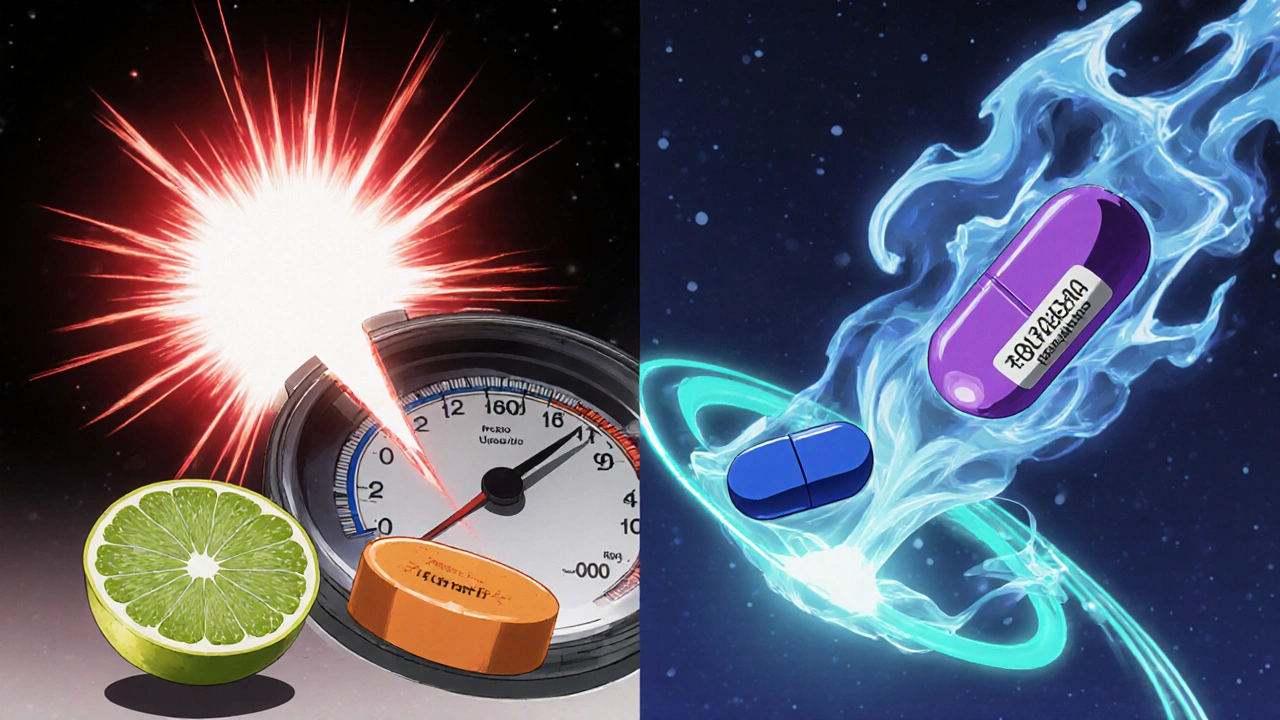Udenafil Drug Interaction Checker
Enter the medications you are taking to check for potential interactions with Udenafil. This tool helps identify possible drug interactions that could affect your safety and treatment effectiveness.
Mixing medicines can turn a harmless treatment into a health risk. If you’ve been prescribed Udenafil, knowing which other drugs can clash with it is crucial. This guide breaks down the most common interactions, explains why they matter, and gives practical steps to stay safe.
What is Udenafil?
Udenafil is a phosphodiesterase type 5 (PDE5) inhibitor used to treat erectile dysfunction. First approved in South Korea in 2005, it works by relaxing smooth muscle in the penis, allowing increased blood flow during sexual stimulation. The typical oral dose ranges from 50 mg to 200 mg, taken once daily or as needed.
How Udenafil Works
Udenafil blocks the enzyme PDE5, which normally breaks down cyclic guanosine monophosphate (cGMP). Higher cGMP levels keep blood vessels dilated, supporting an erection. Because the drug targets a specific enzyme, its effects are largely limited to the genital area-unless another medication amplifies the same pathway.
Common Drug Interactions
Most problems arise when another drug also influences blood pressure, heart rate, or the metabolic enzymes that clear Udenafil from the body. Below are the top culprits.
Nitrates (e.g., nitroglycerin, isosorbide dinitrate)
Nitrates release nitric oxide, dramatically lowering blood pressure. Combine that with Udenafil’s vasodilatory effect and you risk a sudden drop in systolic pressure that can cause fainting, heart attack, or stroke. The interaction is classified as "contraindicated"-meaning the drugs should never be taken together.
Alpha‑blockers (e.g., doxazosin, tamsulosin)
Alpha‑blockers also relax blood vessels, especially in the prostate and bladder. When paired with Udenafil, the additive effect can lead to symptomatic hypotension (dizziness, light‑headedness). Doctors may adjust the alpha‑blocker dose or advise spacing the two medications by at least four hours.
CYP3A4 inhibitors (e.g., ketoconazole, erythromycin, grapefruit juice)
Udenafil is metabolized mainly by the liver enzyme CYP3A4. Strong inhibitors slow clearance, raising plasma levels and prolonging the erection‑enhancing effect-sometimes beyond safe limits. This can increase the chance of priapism (painful, prolonged erection) or cardiovascular strain.
CYP3A4 inducers (e.g., rifampicin, carbamazepine, St. John’s wort)
Inducers speed up metabolism, lowering Udenafil’s effectiveness. Patients may notice reduced potency and might be tempted to increase the dose, which can backfire if the inducer’s effect wanes.
Antifungal agents (e.g., itraconazole, fluconazole)
Many azole antifungals are moderate CYP3A4 inhibitors. Taking them with Udenafil can boost drug exposure by up to 50 %, meaning side‑effects appear at lower doses.
Antihypertensives (e.g., beta‑blockers, ACE inhibitors)
While most antihypertensives are safe, combining them with Udenafil may still cause a modest extra dip in blood pressure, especially in patients with already low baseline readings. Monitoring is advised during the first few weeks.

Interaction Comparison Table
| Drug/Class | Interaction Type | Effect on Patient | Clinical Recommendation |
|---|---|---|---|
| Nitrates | Contraindicated | Severe hypotension, syncope | Avoid co‑administration entirely. |
| Alpha‑blockers | Potential additive hypotension | Dizziness, fainting risk | Separate dosing by ≥4 h; start alpha‑blocker at low dose. |
| CYP3A4 inhibitors | Increased Udenafil exposure | Priapism, cardiovascular stress | Reduce Udenafil dose by 50 % or avoid. |
| CYP3A4 inducers | Decreased Udenafil exposure | Reduced efficacy | Consider alternative PDE5 inhibitor. |
| Azole antifungals | Moderate exposure increase | Headache, flushing | Monitor; limit Udenafil to lowest effective dose. |
| Antihypertensives | Mild additive BP drop | Possible dizziness | Check BP after first combined dose. |
Managing Interactions Safely
- Always share your full medication list. Include prescription drugs, over‑the‑counter pills, supplements, and herbal extracts.
- Ask your pharmacist to check for CYP3A4‑related warnings. Many interaction checkers flag them automatically.
- If you need a nitrate for angina, switch to a different class of erectile‑dysfunction therapy (e.g., vacuum devices) rather than risk a dangerous combo.
- When starting a new antibiotic or antifungal, schedule a brief follow‑up with your doctor to confirm the Udenafil dose remains appropriate.
- Never self‑adjust the dose based on how you feel. Pharmacokinetic changes can be subtle yet clinically significant.
When to Seek Medical Help
Even with careful planning, side‑effects can appear. Contact a health professional immediately if you notice:
- Chest pain, tightness, or irregular heartbeat.
- A painful erection lasting longer than four hours (priapism).
- Severe dizziness, fainting, or sudden drop in blood pressure.
- Vision changes such as blurring or loss of color perception.
These signs may indicate an interaction that’s gone beyond a mild nuisance.
Key Takeaways
- Udenafil is a PDE5 inhibitor cleared mainly by CYP3A4.
- Never combine it with nitrates-risk of life‑threatening hypotension.
- Alpha‑blockers, strong CYP3A4 inhibitors, and some antifungals need dose adjustments or close monitoring.
- Inducers can make the drug less effective; consider alternative therapies.
- Open communication with your prescriber and pharmacist is the safest way to avoid dangerous combos.
Frequently Asked Questions
Can I take Udenafil with my blood pressure medication?
Most antihypertensives are safe, but a slight extra drop in blood pressure can occur. Check your BP after the first combined dose and talk to your doctor if you feel light‑headed.
Is it okay to drink grapefruit juice while on Udenafil?
Grapefruit juice is a moderate CYP3A4 inhibitor. It can raise Udenafil levels enough to increase side‑effects. Limit intake or choose a different fruit juice.
What should I do if I accidentally take a nitrate and Udenafil together?
Seek emergency medical care right away. The combination can cause a rapid, dangerous drop in blood pressure.
Do herbal supplements like St. John’s wort affect Udenafil?
Yes. St. John’s wort is a CYP3A4 inducer, which may reduce Udenafil’s effectiveness. Discuss any herbal products with your clinician before starting therapy.
Can I safely use Udenafil if I have a mild liver problem?
Mild hepatic impairment often requires a lower starting dose because the liver clears Udenafil. Your doctor will likely prescribe 50 mg and monitor response.

Rachael Turner
October 22, 2025 AT 18:20